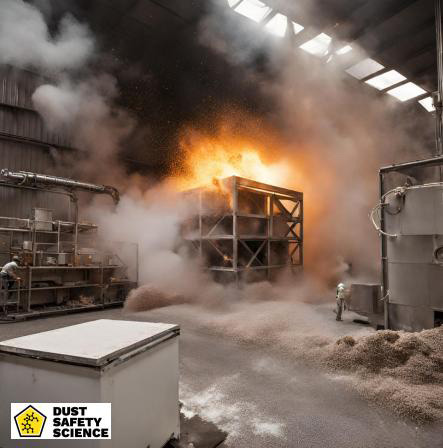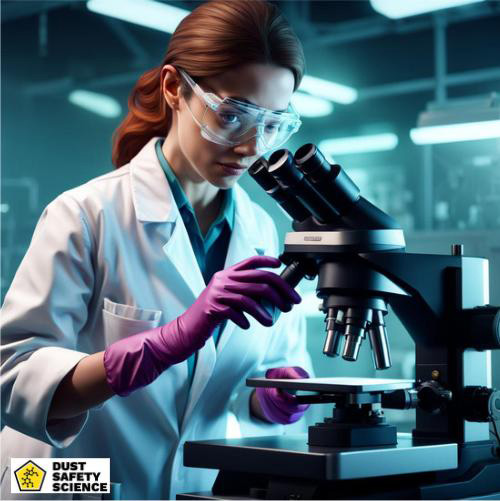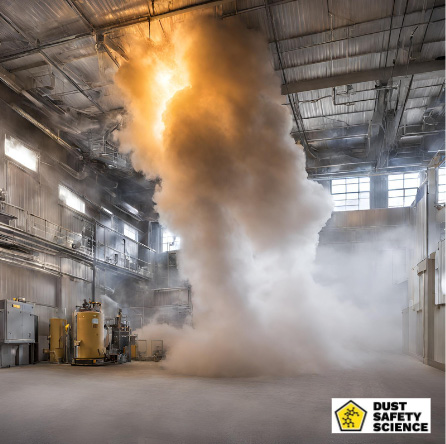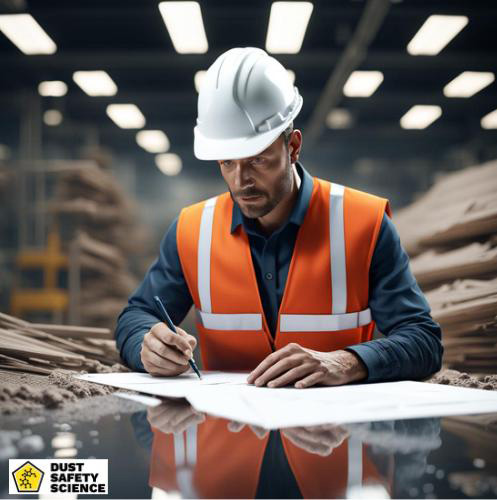Updated March 20, 2025 Authored by Dr. Chris Cloney and Jon Barrett of Dust Safety Science
Combustible dust testing is important for industries to spot materials that can cause explosions, so effective measures will be put in place.

Fine particles or combustible dust can accumulate in industrial environments that handle and process materials. Combustible dust testing mitigates explosion risks by analyzing dust samples to determine their explosiveness. This process is essential for spotting potential hazards and creating safety protocols to protect workers and workplaces from dust-related incidents.
Key Takeaways:
- Hazard Assessment: Combustible dust testing is essential for assessing the presence and level of risk associated with combustible dust hazards and dust explosions in industrial settings.
- Material Characterization: Understanding the physical properties of dust particles, such as dust shape, particle size analysis, chemical composition, Limiting Oxygen Concentration, and moisture content, is fundamental for evaluating their combustibility. Using a scanning electron microscope for dust testing, will confirm characteristics.
- Safety Measures: Sample dust and test results guide the development of safety measures, including preventive controls, equipment selection, emergency response plans, for process safety management.
- Compliance and Regulations: Compliance with combustible dust testing requirements is often mandated by regulations and standards to ensure worker safety and facility protection, from a dust explosion, and combustible dust hazards.
- Ongoing Monitoring: Regular sample dust testing and continuous monitoring are crucial for maintaining a safe workplace, and to prevent a dust explosion, as conditions and materials can change over time. Dust handling components, such as dust collection systems, are a high source of dust explosions. A hot surface ignition temperature of dust layers can be identified as well.
Unlock expert insights to keep your workplace safe.
Table of Contents:
- All About Combustible Dust Testing
- The Importance of Combustible Dust Testing
- How to Determine if Dust is Combustible Dust
- Methods Used and Laboratory Tests for Combustible Dust
- Interpreting Combustible Dust Testing Results
- Why A Dust Hazard Analysis is Crucial for Your Facility and Combustible Dust Testing
- Practical Tips for Effective Combustible Dust Testing
- Record-Keeping of Combustible Dust Testing
All About Combustible Dust Testing

Combustible dust testing is a specialized form of dust testing from dust samples, that hones in on materials prone to combustion when there is a dust layer or dust dispersed in the air. Dust testing is crucial for industries where the presence of poses significant safety risks. By subjecting these materials to rigorous testing procedures, such as the explosion severity test, we can identify their potential for combustible dust explosion and fire hazards and, as a result, a cost-effective method for prevention. Some highly abrasive dust can be tested and analyzed and prevent equipment failures and abnormal equipment wear and tear. If a dust collector inlet velocity is too high, the dust will abrade the filters and cause premature wear, requiring a low inlet velocity.
Sample dust testing is also a critical process used to evaluate and mitigate the risk of combustible dust explosions in various industries that handle combustible particulate materials and process materials with dust-handling components. Combustible dust refers to finely divided solid particles, often generated during manufacturing, processing, or handling of materials like metals, wood, plastics, chemicals, and agricultural products, which can create a dust explosion when suspended in the air, as a dust cloud, in the right conditions. There can be many different dust layers in a manufacturing facility, requiring many dust samples, including filter media, and in a dust collection system. When capturing highly abrasive dust in dust collection equipment, testing can identify and prevent premature wear on filter media and downstream equipment, resulting in cost-effective maintenance. A dust collector must be designed with low inlet velocity. If inlet velocity is too high, the dust will abrade the filters and cause premature wear. In addition, a plasma cutter produces carbon dust and exhaust dust with extremely small particulates, as hazardous materials, requiring a possible particle size analysis.
The Importance of Combustible Dust Testing

Safety Concerns
Combustible dust poses significant safety risks across various industries. When fine particles of flammable materials, such as wood dust, form a dust layer and become airborne as a dust cloud, they can lead to catastrophic dust explosions and fires. This is where sample dust testing plays a pivotal role in identifying combustible dust hazards and preventing combustible dust explosions.
From preventing a dust layer, dust clouds, and a possible dust explosion to safeguarding workers and assets, the dust testing process, such as the explosion severity test, is a vital component of ensuring workplace safety from dust handling components, regulatory compliance, and process safety management.
Regulatory Requirements
Overview of governmental and industry regulations requiring dust testing, with a particular focus on Occupational Safety and Health Administration (OSHA), National Fire Protection Association (NFPA), and American Society for Testing and Materials (ASTM) regulations. Ensuring safety in environments susceptible to combustible dust and a dust cloud is paramount. Governmental agencies like OSHA and industry standards such as the NFPA 660 standard for combustible dust have established strict regulations that mandate dust testing as a crucial element of combustible dust safety compliance to prevent combustible dust hazards, hazardous materials incidents, a dust cloud, and dust explosion.
Financial Implications
Failing to prioritize dust testing in industrial and occupational settings can lead to dire financial repercussions. Regulatory agencies impose substantial fines for non-compliance with combustible dust safety standards, which can result in severe financial setbacks for businesses.
Moreover, the risk of accidents caused by hazardous materials such as combustible dust and a dust explosion can result in catastrophic financial losses, including property damage, facility shutdown, legal liabilities, and increased insurance premiums.
Is Household Dust Flammable?
Household dust is composed of a variety of dust layers and tiny particles, including skin cells, pet dander, pollen, and minute debris from daily activities. While household dust itself is not typically flammable, it can become a fire hazard under certain conditions. When disturbed, fine particles of dust can become suspended in the air, forming a dust cloud. If this cloud encounters an ignition source, such as an electrical spark or static electricity, from a minimum temperature, this process can lead to a flash fire.
To mitigate the risk, regular cleaning and dust control measures are essential to prevent dust buildup in filter media and the formation of flammable dust clouds in the home. Understanding this potential hazard highlights the importance of maintaining a clean and safe living environment.
Example materials that have resulted in combustible dust explosions, combustible dust fires and flash-fires in non-commercial environments include a dust layer of fine flour products, icing sugar, fine sawdust, cornstarch and baby powder. Dust samples of these materials may require sample dust explosion testing, with a minimum ignition energy and a particle size analysis. This mass spread of dust can also include other hazardous dust, such as lead, asbestos, and fiberglass.
How to Determine if Dust is Explosive, Combustible Dust:
Preliminary Assessment
Combustible dust can lead to devastating combustible dust fires and combustible dust explosions in industrial settings, making it essential to assess its potential explosion hazards. Here are the initial steps to indicate whether dust is likely to be combustible:
Dust Identification: Begin by identifying the type of dust present in your workplace. Different dust types have varying combustibility properties and classifications. Common combustible dust materials include wood, metal, plastics, carbon dust, and organic compounds. Some industries have a hybrid mix dust layer or mass spread of dust, requiring many dust samples. Capturing highly abrasive dust in dust collection equipment can prevent premature wear on filter media and downstream equipment.
Particle Size: Evaluate the dust particle size distribution of the dust. Smaller particles are more likely to be combustible because they have a higher surface area and can easily become suspended in the air. A scanning electron microscope (SEM) is used for visual analysis of the dust shape and characteristics. An example might be the exhaust dust from a plasma cutter includes submicron carbon particles mixed with much larger steel particles.
Dust Concentration: Determine the concentration of dust in the environment. Combustible dust hazards are more significant when the dust concentration is above a certain threshold, typically expressed as grams per cubic meter (g/m³).
Oxygen Availability: Assess the availability of oxygen concentration in the area. Combustion requires an oxygen concentration, so areas with ample airflow may be at a higher risk of dust combustion. The Limiting Oxygen Concentration, LOC, defines the lowest oxygen concentration required to support combustion.
Ignition Sources: Identify potential ignition sources in the vicinity of the dust layer. A hot surface ignition temperature could be from a frayed computer wire or loose bearing. Common ignition sources include open flames, hot surfaces, electrical equipment, and static electricity.
Moisture Content: Consider the moisture content of the dust. A Dry dust layer is more prone to combustion than wet dust. Ensure that dust storage and handling procedures maintain a suitable moisture level.
Dust Cloud Formation: Assess whether the dust can form a combustible dust cloud in the air. Dust clouds are highly dangerous as they can ignite and propagate explosions rapidly. Testing uses dry compressed air to form a dust cloud.
Material Properties: Study the chemical properties of the dust, such as its flashpoint, autoignition temperature, and explosibility limits. These parameters can provide critical insights into the dust’s potential to combust.
Historical Incidents: Investigate whether there have been any previous incidents related to dust explosions or fires in your facility or industry. Past dust explosion incidents can indicate the presence of combustible dust hazards, and other hazardous materials, causing combustible dust explosions
Safety Measures: Finally, review the existing combustible dust safety measures and controls in place, to assist with process safety management. Ensure that appropriate dust handling components have proper dust control and mitigation strategies and are implemented. The measures include a dust collection system, explosion venting, anti-static, personal protective equipment and explosion-proof and anti-static equipment. These measures help prevent combustible dust explosions.
Enhance your safety knowledge today. Sign up now for expert guidance.
Methods Used and Laboratory Tests for Combustible Dust Physical Properties

There are essential laboratory tests that provide definitive confirmation of the combustibility of dust. In industrial and safety contexts, understanding the combustibility of dust is paramount to prevent catastrophic, combustible dust explosions. When testing for a dust sample in downstream equipment, this process may result in cost-effective maintenance. A SEM is used for visual analysis of the dust shape and characteristics. The various types of laboratory tests, and dust explosion testing, including explosibility tests, dust particle size distribution analysis, and thermal analysis, shedding light on their methodologies, significance, and practical applications include:
Explosibility Tests: Combustible Dust Laboratory explosibility tests are a cornerstone for assessing dust combustibility. These Combustible Dust Laboratory tests replicate conditions where dust clouds could ignite and explode by using dry compressed air. The widely used tests include the Maximum Explosion Pressure (P max ), Maximum Rate of Pressure Rise, and Minimum Explosible Concentration (MEC). These experiments measure parameters like ignition sensitivity, dust cloud deflagration, flame propagation, rate of pressure rise resulting from the expanding fireball, and the maximum explosion pressure developed. The minimum explosible concentration measures the minimum amount of dust dispersed in the air required to spread an explosion. Testing the maximum pressure of the resulting deflagration is used in the design of explosion protection systems, such as explosion vents.
Go/No Go Explosion Screening: This Combustible Dust Laboratory test is used to quickly identify if a sample combustible dust is reactive as a cloud. This determination can be made based on the approach identified in ASTM standards for screening tests or based on the results of the Explosibility Tests above.
Particle Size Analysis: Particle size plays a crucial role in dust combustibility. Laser diffraction and sieve analysis are common techniques for determining dust particle size distribution. Smaller particles have a higher likelihood of forming explosive dust clouds, making dust particle size distribution analysis a key factor in risk assessment.
Thermal Analysis: Differential Scanning Calorimetry (DSC) and Thermogravimetric Analysis (TGA) are thermal analysis methods that help identify the thermal stability and reactivity of dust particles. DSC measures heat flow during temperature changes, indicating exothermic reactions, while TGA measures changes in weight as a function of temperature.
Autoignition Temperature Testing: Autoignition temperature tests determine the minimum temperature at which dust particles can spontaneously ignite in air. This data is essential for understanding the dust’s susceptibility to ignition under various conditions.
Minimum Ignition Energy (MIE) Testing: Minimum ignition energy, MIE, tests measure the minimum electrical energy required to ignite a dust cloud. This Minimum ignition energy, (MIE). parameter is crucial for assessing the risk posed by electrical equipment in dust-laden environments.
Limiting Oxygen Concentration (LOC) Testing: Limiting Oxygen Concentration (LOC) tests determine the lowest oxygen concentration at which a dust cloud can ignite and sustain combustion. Understanding LOC aids in creating safer atmospheres by controlling oxygen levels.
Electrostatic Testing: Electrostatic discharge can be a significant ignition source in environments with combustible dust. Laboratory tests assess a material’s electrostatic properties, helping to identify potential hazards.
Adiabatic Calorimetry: Adiabatic calorimetry measures the heat released during a chemical reaction. This test provides insights into the dust’s combustion behavior, including the heat of combustion and the potential for self-sustaining reactions.
X-ray Diffraction (XRD): XRD is used to identify the crystalline structure of dust particles, which can impact their reactivity and ignition characteristics.
Simulated Process Testing: Some laboratory tests simulate specific industrial processes or equipment to assess the risk of dust combustion under real-world conditions.
Dual Laser Particle Analyzer: A dual laser particle analyzer to determine the distribution of particles across a range of sizes and the volume or mass spread of the dust. A dual laser particle analyzer is specially designed for submicron, nanoemulsions and nano particle size testing with the Principle of Dynamic Light Scattering. A dual laser particle analyzer can identify particles that are less than a micron in size.
Interpreting Combustible Dust Testing Results
Understanding how to analyze combustible dust testing results is essential for effectively managing and mitigating combustible dust hazards, and preventing a dust explosion, in industrial settings. Interpreting dust combustibility testing results and taking appropriate actions may include:
Non-Combustible Dust:
Interpretation: If combustible dust Laboratory testing results confirm that the dust is non-combustible, this is a favorable outcome. It means that the combustible dust does not pose a significant risk of combustion or explosion under normal conditions. However, some highly abrasive dust can be analyzed and prevent equipment failures and abnormal wear and tear.
Actions: While non-combustible dust is relatively safe, it’s essential to maintain good housekeeping practices to prevent the accumulation of dust, which can still pose health and operational risks. Regular cleaning and dust control measures should be implemented, to prevent a dust explosion.
Combustible Dust with Low Hazard Potential:
Interpretation: Some dust may be combustible but have a low hazard potential due to factors such as high autoignition temperatures or high MIE values.
Actions: In this case, preventive measures should still be implemented to minimize the risk further. These may include proper combustible dust containment, ventilation, and fire suppression systems. Regular inspections and monitoring are essential to ensure safety, preventing a dust explosion.
Combustible Dust with Moderate Hazard Potential:
Interpretation: Combustible Dust Laboratory Testing results indicate that the dust is combustible and poses a moderate hazard. The combustible dust may have lower ignition thresholds, but it’s not highly reactive.
Actions: Employ rigorous preventive measures, including dust control and housekeeping protocols, to prevent dust clouds. Implement explosion protection systems, such as explosion venting, suppression or isolation, to mitigate the potential for explosions. Training employees on safe practices becomes even more critical, in preventing a dust explosion.
Highly Combustible Dust:
Interpretation: Highly combustible dust presents a significant risk of combustion and explosion. Testing results indicate low ignition energy, low autoignition temperature, and high explosibility. Testing the maximum pressure of the resulting deflagration, are used in the design of explosion protection systems, such as explosion vents.
Actions: In this scenario, strict controls and preventive measures are imperative. Isolate dust-producing processes as much as possible. Employ advanced dust explosion protection systems, such as deflagration venting, chemical suppression or isolation, to prevent catastrophic events. Be sure to ensure that equipment is certified for these materials and that the equipment is installed and maintained for the intended use for which the certifications were tested against. Comprehensive training and emergency response plans are essential.
Out-of-Spec Results or Uncertainty:
Interpretation: Sometimes, testing results may be inconclusive or fall outside established safety standards. This can sometimes occur for non-traditional dusts such as fibers, nanoparticles and hybrid mixtures as an example.
Actions: In cases of uncertainty, it’s crucial to reevaluate the testing process and consult with experts in dust combustibility. Err on the side of caution and implement safety measures appropriate for the highest potential hazard level until further clarification is obtained.
Equip yourself with essential safety skills—join our training today!
Continuous Monitoring and Review:
Interpretation: Regardless of the initial test results, ongoing monitoring and periodic retesting are vital to adapt to changes in the workplace environment or processes.
Actions: Continuously assess and improve dust control measures, employee training, and safety protocols based on real-world observations and feedback.
Why A Dust Hazard Analysis is Crucial for Your Facility and Combustible Dust Testing
- What is Dust Hazard Analysis (DHA)?
A DHA is a systematic review to identify and evaluate the potential fire, flash fire, or explosion hazards associated with the presence of one or more combustible particulate solids in a process or facility (NFPA 652-19). The Importance of Dust Hazard Analysis is to identify fire, flash fire, dust explosion hazards, dust cloud formation, the maximum pressure of the explosion for sizing vents, and a possible mass spread of dust that poses a risk to people and property. Obtaining dust samples and dust testing is an important part of performing your Dust Hazard Analysis and Assessment: Combustible Dust Hazard Analysis. - Importance of DHA
Why DHA is important can’t be overstated for facilities handling dust. It forms the foundation for a proactive approach to dust-related safety, regulatory compliance, and responsible operations. A DHA isn’t just a requirement; it’s a commitment to protecting people, property, and the environment while ensuring the long-term success of the facility. A DHA may also identify whether a dust collector is designed with low inlet velocity to extend the life of the filters.
Practical Tips for Effective Combustible Dust Testing to Prevent Dust Explosions

Effective dust testing is pivotal in identifying and mitigating combustible dust hazards. To ensure accurate results and streamline your testing process, consider the following practical tips and best practices:
- Sample Collection:
Gather dust samples representative of the actual workplace conditions. Collect samples from various locations, dust collection system equipment, and processes to account for variability. Use proper tools and containers to prevent contamination during collection.
- Document Sample Information:
Maintain detailed records of sample collection, including location, date, time, and relevant environmental conditions (e.g., temperature and humidity). Clearly label each sample container with pertinent information.
- Standardized Testing Procedures
Follow recognized testing standards, such as those established by NFPA, ASTM, or other relevant industry bodies. Adhere to a consistent testing methodology for repeatability and comparability of results.
- Quality Control:
Implement rigorous quality control measures throughout the testing process.
Use certified reference materials and calibration standards to validate testing equipment.
- Safety Precautions:
Prioritize safety during testing to prevent accidents or dust-related incidents.
Conduct testing in controlled environments with appropriate safety measures.
- Sample Preparation:
Ensure that combustible dust samples are prepared consistently and accurately, avoiding changes in particle size distribution. Maintain sample integrity to prevent contamination or alteration. Different dusts can be mixed in a dust collection system, such as carbon dust, requiring a particle size analysis.
- Test Equipment Maintenance:
Regularly calibrate and maintain scanning electron microscope and testing equipment to ensure accuracy and reliability. Keep records of equipment maintenance and calibration schedules.
- Data Interpretation:
Thoroughly analyze and interpret test results, considering factors like autoignition temperature, minimum ignition energy, and explosibility limits. Seek expert guidance if results are inconclusive or complex.
- Reporting and Documentation:
Generate clear and concise test reports, including methodology, results, and conclusions. Document any deviations from standard procedures and provide justifications.
- Continuous Learning and Improvement:
Stay updated with industry advancements and evolving testing standards.
Foster a culture of continuous improvement in your testing processes.
- Collaboration and Expert Consultation:
Collaborate with experts and peers in the field to share knowledge and experiences.
Consult with experts when dealing with complex dust samples or unique testing requirements.
By adhering to these practical tips and best practices, you can enhance the effectiveness and efficiency of your dust testing efforts. Accurate and reliable testing is fundamental for identifying and managing combustible dust hazards, thereby ensuring safety and compliance with industry regulations, and help prevent a flash fire, other explosion hazards, and combustible dust explosions.
Frequency of Combustible Dust Testing
Determining how often to conduct dust testing is essential for managing combustible dust hazards and explosion hazards effectively. The following guidance offers insights into establishing appropriate testing schedules:
- Regulatory Requirements:
Refer to industry-specific regulations and standards, such as those from OSHA, NFPA, ASTM, or local authorities, to identify mandated testing intervals. Compliance with these regulations is often non-negotiable. The American Society for Testing and Materials, ASTM E1226-19 and ASTM E1515-14 are the most common standards used for Deflagration testing in North America:
ASTM E1226-19 Standard Test Method for Explosibility of Dust Clouds, Significance and Use:
ASTM E1226-19 is a standard test method that plays a crucial role in assessing the explosibility of dust clouds, an essential consideration for industries dealing with potentially combustible materials. The significance of this standard lies in its ability to provide a systematic and standardized procedure for determining whether a dust cloud has the potential to explode when exposed to an ignition source. By defining the conditions necessary for an explosion, this method helps industries identify and manage risks associated with dust hazards, enhancing safety. It also assists in the development of appropriate safety measures and compliance with regulatory requirements. ASTM E1226-19 serves as a valuable tool for industries, helping them minimize the potential for dust-related accidents and ensuring safe working environments.
ASTM E1515-14 Standard Test Method for Minimum Explosible Concentration of Combustible Dusts, Significance and Use:
ASTM E1515-14 is a standard test method that outlines procedures for determining the Minimum Explosible Concentration (MEC) of combustible dust. This standard is essential for industries and organizations dealing with combustible dust, as it provides a systematic and reliable way to assess the lowest concentration of dust in the air that can potentially result in an explosion. The MEC is a critical parameter for maintaining workplace safety, preventing dust-related accidents, and ensuring compliance with relevant regulations. ASTM E1515-14(2022) offers a standardized approach to conducting these tests, making it an invaluable tool for risk assessment, hazard analysis, and the development of appropriate safety measures within various industrial settings. Additional guidance on go/no go testing and explosibility testing can also be found in ASTM E1515.
- Industry Practices:
Research industry best practices and benchmarks to understand typical testing frequencies for facilities similar to yours. For example, many workers and safety personnel, are not aware a plasma cutter produces carbon dust and exhaust dust, with extremely small particulates. Another example is a dust collector must be designed with low inlet velocity. If inlet velocity is too high, the dust will abrade the filters and cause premature wear. A particle size analysis might be required. These practices can serve as a valuable starting point.
- Process Changes:
Whenever significant changes occur in your processes, materials, equipment, or facility layout, reevaluate your testing frequency. New processes may introduce new hazards that require more frequent testing.
- Historical Incident Data:
Review your facility’s incident history related to combustible dust. If you’ve had past incidents or near-misses, consider increasing the frequency of testing to mitigate similar risks.
- Material Characteristics:
Dust characteristics, such as dust shape, particle size analysis, Limiting Oxygen Concentration, moisture content, and chemical composition, can change over time. Regular testing helps account for variations in these properties.
- Environmental Factors:
Environmental conditions, such as oxygen concentration, temperature, and humidity, can influence the combustibility of dust. Factor in seasonal changes or variations in your testing schedule.
- Preventive Maintenance:
Coordinate dust testing with preventive maintenance schedules. This ensures that testing occurs when a dust collection system and other equipment are offline and accessible for inspection.
- Frequency Tiers:
Establish testing frequency tiers based on risk levels. For example, high-risk areas may require more frequent testing than low-risk areas. A particle size analysis might be required with mixed dust.
- Continuous Monitoring:
Consider implementing continuous monitoring systems for critical processes or areas that form dust and possible dust clouds. These systems can provide real-time data and trigger additional testing when necessary.
- Safety Culture:
Foster a safety culture that encourages proactive hazard identification. Encourage employees to report unusual conditions that may warrant immediate testing. Smoke, sparks, and exhaust dust particulate from a plasma cutter are examples.
- Expert Consultation:
Seek guidance from experts in combustible dust safety or industrial hygiene. They can provide insights into specific testing requirements for your facility.
- Flexibility and Adaptation:
Maintain flexibility in your testing schedule to adapt to changing conditions or unforeseen events. Be prepared to increase or decrease testing frequency as needed.
The frequency of dust testing should align with regulatory requirements, industry standards, and the unique characteristics of your facility. Regular testing is crucial for preventing combustible dust incidents and ensuring ongoing safety and compliance. By considering these factors and adopting a proactive approach, you can establish an effective testing schedule that meets your facility’s specific needs.
Record-Keeping of Dust Sampling and Combustible Dust Testing

Record-keeping is a fundamental aspect of dust testing for combustible hazards, offering a multitude of benefits for safety, compliance, and operational excellence. Here’s a look at why maintaining records and documentation is of paramount importance:
- Regulatory Compliance:
Many regulatory authorities, such as OSHA and NFPA, require facilities to maintain records of dust testing activities. Compliance with these regulations is not only essential for avoiding penalties but also for ensuring a safe working environment.
- Liability Protection:
Accurate records can serve as evidence of diligent safety measures in the event of an incident or legal dispute. They can help protect your organization from liability claims and potential lawsuits.ing environment.
- Incident Investigation:
In the unfortunate event of a dust-related incident, thorough records can assist in root cause analysis, identify dust layers which may form a dust cloud, and post-incident investigations. This information is invaluable for identifying areas for improvement and preventing future incidents.
- Trend Analysis:
Over time, records provide a historical perspective on dust testing results. This data enables trend analysis, helping you identify patterns or deviations that may require corrective action.
- Maintenance and Calibration:
Records should include details about equipment maintenance, calibration schedules, and verification procedures. Well-maintained equipment ensures the accuracy of test results.
- Training and Documentation:
Records can support employee training by serving as reference materials for safety procedures and best practices. New hires can benefit from the institutional knowledge preserved in records.
- Continuous Improvement:
Detailed records can facilitate continuous improvement efforts in dust control and safety protocols. Regular reviews of past testing results can guide future risk mitigation strategies.
- Reporting and Communication:
Records are essential for generating clear and comprehensive test reports. They provide a basis for effective communication with regulatory authorities, insurers, and internal stakeholders.
- Audit Preparedness:
Thorough record-keeping ensures readiness for regulatory audits. When authorities or third-party auditors review your records, well-organized documentation reflects a commitment to safety and compliance and combustible dust hazard management.
- Change Management:
Records are instrumental in change management processes. When processes, equipment, or materials change, records help evaluate the potential impact on dust hazards and safety measures.
- Knowledge Transfer:
Records serve as a valuable resource for knowledge transfer within the organization. They preserve critical information that can be passed down through personnel changes or retirements.
Meticulous record-keeping is not just a bureaucratic requirement but a cornerstone of effective dust testing and safety management. By maintaining accurate records and documentation, facilities can demonstrate commitment to safety, ensure compliance with regulations, and continually improve their dust hazard management practices. This, in turn, leads to a safer work environment and enhanced protection against potential liabilities.
Conclusion
The safety and compliance of facilities dealing with dust are critically dependent on thorough Combustible Dust testing. Dust testing and DHA are not optional but imperative for compliance and cost effective safety measures. The consequences of neglecting these practices can be catastrophic, leading to injuries, property damage, regulatory penalties, facility shutdown, legal liabilities, and reputational harm. Industries and facilities must prioritize these activities as integral components of their safety and risk management strategies.
By conducting regular testing, maintaining accurate records, and fostering a culture of safety, facilities can effectively identify, mitigate, and prevent combustible dust hazards. This commitment not only ensures compliance with regulations but also upholds the well-being of employees and the integrity of operations. Dust testing is an investment in safety that pays dividends in the form of a safer workplace, protected assets, and peace of mind for all stakeholders.
Don’t leave safety to chance—contact us for expert advice on combustible dust.
About Dust Safety Science
Dr. Chris Cloney, of Dust Safety Science, provides additional Combustible Dust Testing information, with a Podcast. Click on the latest Podcast Link: Understanding the Combustible Dust Testing Process with Martin Clouthier.

Resources:
Visit Dust Safety Science (Global Incident Tracking)
Visit Dust Safety Academy (Resources, Training and Events)
Visit Dust Safety Professionals (Need Help? Get Support Today!)
Visit Dust Safety Journal for the Dust Safety Science Monthly Journal
Subscribe to our Dust Safety Science Newsletter at Dust Safety Science Newsletter
Visit the Dust Safety Science blog for written articles on combustible dust safety including the latest research, expert opinions, and state-of-the art in fire and explosion protection.
